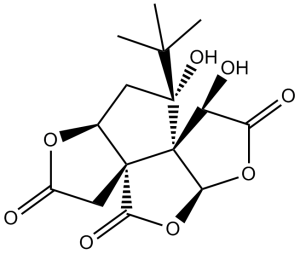Bilobalide (BB) is a naturally occuring and biologically active terpenic trilactone isolated from Ginkgo biloba (GB). In vitro experiments showed that inhibition by BB and GB was eliminated in mutant receptors containing T6'S and S12'A substitutions, but their potencies were increased (42 and 125-fold, respectively) in S2'A mutant receptors, demonstrating the neuroprotective effects of this compound. By decreasing the β amyloid protein (A), a Aβ by-product of amyloidogenic processing of APP, and increasing the secretion of -secretase-cleaved soluble amyloid precursor protein (sAPPα), BB improved non-amyloidogenic processing of APP.
Physicochemical Properties
| Molecular Formula | C15H18O8 | |
| Molecular Weight | 326.3 | |
| Exact Mass | 326.1 | |
| Elemental Analysis | C, 55.21; H, 5.56; O, 39.23 | |
| CAS # | 33570-04-6 | |
| Related CAS # |
|
|
| PubChem CID | 73581 | |
| Appearance | White to off-white solid powder | |
| Density | 1.6±0.1 g/cm3 | |
| Boiling Point | 651.7±55.0 °C at 760 mmHg | |
| Flash Point | 247.5±25.0 °C | |
| Vapour Pressure | 0.0±4.4 mmHg at 25°C | |
| Index of Refraction | 1.606 | |
| LogP | -0.45 | |
| Hydrogen Bond Donor Count | 2 | |
| Hydrogen Bond Acceptor Count | 8 | |
| Rotatable Bond Count | 1 | |
| Heavy Atom Count | 23 | |
| Complexity | 650 | |
| Defined Atom Stereocenter Count | 6 | |
| SMILES | O=C(O1)C[C@@]2([C@]1([H])C[C@]3(C(C)(C)C)O)[C@@]34[C@](OC([C@@H]4O)=O)([H])OC2=O |
|
| InChi Key | MOLPUWBMSBJXER-YDGSQGCISA-N | |
| InChi Code | InChI=1S/C15H18O8/c1-12(2,3)14(20)4-6-13(5-7(16)21-6)10(19)23-11-15(13,14)8(17)9(18)22-11/h6,8,11,17,20H,4-5H2,1-3H3/t6-,8-,11-,13-,14+,15+/m0/s1 | |
| Chemical Name | (1S,4R,7R,8S,9R,11S)-9-tert-butyl-7,9-dihydroxy-3,5,12-trioxatetracyclo[6.6.0.01,11.04,8]tetradecane-2,6,13-trione | |
| Synonyms |
|
|
| HS Tariff Code | 2934.99.9001 | |
| Storage |
Powder-20°C 3 years 4°C 2 years In solvent -80°C 6 months -20°C 1 month |
|
| Shipping Condition | Room temperature (This product is stable at ambient temperature for a few days during ordinary shipping and time spent in Customs) |
Biological Activity
| Targets | Human Endogenous Metabolite | ||
| ln Vitro |
Bilobalide (1-100 µM) completely suppresses the NMDA-evoked release of choline in a concentration-dependent manner with IC50 value of 2.3 µM[1]. Bilobalide (1, 5 and 10 μM) alone for 24 h does not affect cell viability of SH-SY5Y cells. The best protective effect was obtained at 10 μM[2], and pre-treating cells with bilobalide prevents Aβ 1-42, H2O2, and serum deprivation-induced decreases in cell viability. Bilobalide (5 and 10 μM; 24 h) treatment dose-dependently raises levels of p-Akt (Ser473 and Thr308) in SH-SY5Y cells[2]. |
||
| ln Vivo | Bilobalide (20 mg/kg) completely suppresses the NMDA-induced release of choline in vivo while basal choline levels were not significantly affected. When NMDA is retrograde dialyzed into the hippocampus of freely moving rats, this results in the release of choline in vivo. The effect caused by NMDA is completely inhibited by bilobalide (20 mg/kg intravenously)[1]. | ||
| Animal Protocol |
|
||
| References |
[1]. Bilobalide, a constituent of Ginkgo biloba, inhibits NMDA-induced phospholipase A2 activation and phospholipid breakdown in rat hippocampus. Naunyn Schmiedebergs Arch Pharmacol. 1999 Dec;360(6):609-15. [2]. Bilobalide prevents apoptosis through activation of the PI3K/Akt pathway in SH-SY5Y cells. Apoptosis. 2010 Jun;15(6):715-27. |
||
| Additional Infomation |
Bilobalide is a terpenoid trilactone found in extracts of Ginkgo biloba. Bilobalide has been reported in Ginkgo biloba with data available. See also: Ginkgo (part of). |
Solubility Data
| Solubility (In Vitro) |
|
|||
| Solubility (In Vivo) |
Solubility in Formulation 1: ≥ 2.08 mg/mL (6.37 mM) (saturation unknown) in 10% DMSO + 40% PEG300 + 5% Tween80 + 45% Saline (add these co-solvents sequentially from left to right, and one by one), clear solution. For example, if 1 mL of working solution is to be prepared, you can add 100 μL of 20.8 mg/mL clear DMSO stock solution to 400 μL PEG300 and mix evenly; then add 50 μL Tween-80 to the above solution and mix evenly; then add 450 μL normal saline to adjust the volume to 1 mL. Preparation of saline: Dissolve 0.9 g of sodium chloride in 100 mL ddH₂ O to obtain a clear solution. Solubility in Formulation 2: ≥ 2.08 mg/mL (6.37 mM) (saturation unknown) in 10% DMSO + 90% (20% SBE-β-CD in Saline) (add these co-solvents sequentially from left to right, and one by one), clear solution. For example, if 1 mL of working solution is to be prepared, you can add 100 μL of 20.8 mg/mL clear DMSO stock solution to 900 μL of 20% SBE-β-CD physiological saline solution and mix evenly. Preparation of 20% SBE-β-CD in Saline (4°C,1 week): Dissolve 2 g SBE-β-CD in 10 mL saline to obtain a clear solution. Solubility in Formulation 3: ≥ 2.08 mg/mL (6.37 mM) (saturation unknown) in 10% DMSO + 90% Corn Oil (add these co-solvents sequentially from left to right, and one by one), clear solution. For example, if 1 mL of working solution is to be prepared, you can add 100 μL of 20.8 mg/mL clear DMSO stock solution to 900 μL of corn oil and mix evenly. (Please use freshly prepared in vivo formulations for optimal results.) |
| Preparing Stock Solutions | 1 mg | 5 mg | 10 mg | |
| 1 mM | 3.0647 mL | 15.3233 mL | 30.6466 mL | |
| 5 mM | 0.6129 mL | 3.0647 mL | 6.1293 mL | |
| 10 mM | 0.3065 mL | 1.5323 mL | 3.0647 mL |
